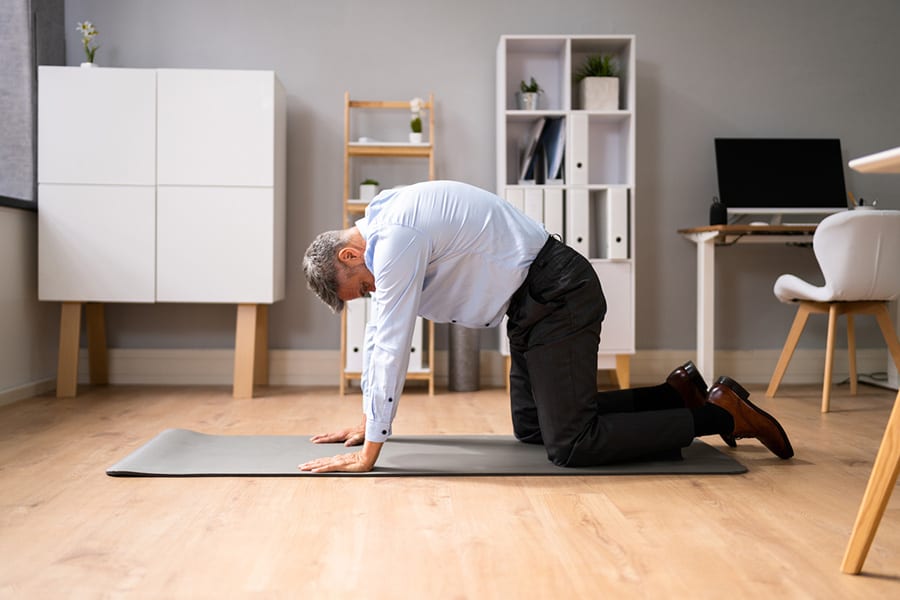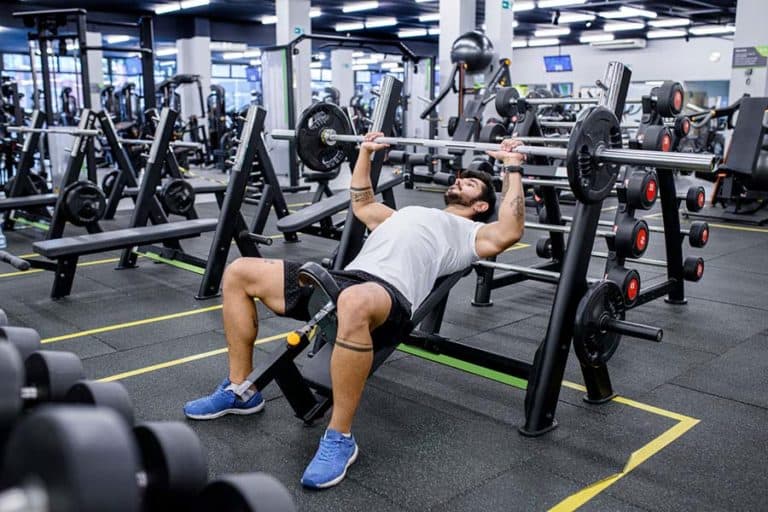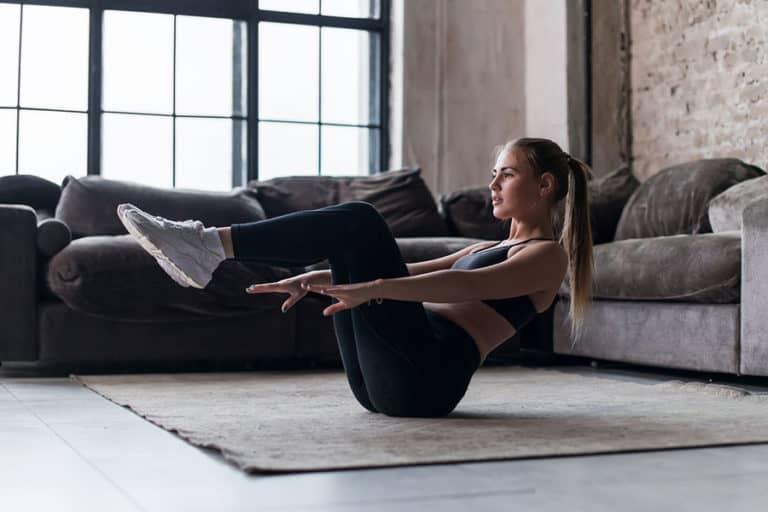12 Effective Posture Exercises to Add To Your Routine

Our posture greatly impacts our overall health and, consequently, the quality of our lives. Posture exercises are a great way to improve posture and reduce the risk of posture-related health complications.
Do you suffer from back pain? Do you find yourself hunching over your computer screen throughout the day? If so, you need to start doing posture exercises! Millions of people worldwide, spend their lives slouching, hunching, and generally in a bad and unhealthy posture. Bad or imperfect posture can lead to a host of health problems, including back pain, neck pain, and even headaches.
Maintaining a healthy posture is an indispensable element of a healthy and fit life. Practicing some simple posture exercises regularly can help in improving posture and your overall health. If you need help to stand taller and live healthier, here’s more on good posture and how you can achieve it with posture exercises.
Posture exercises to fix bad posture
There are variety of exercises that can help in fixing bad posture. For example yoga, tai chi, and other forms of mindful workout[1]Medline Plus: Guide to Good Posture formats that focus on body awareness can promote better posture. Listed below are 12 effective posture exercises and the guidelines on how to do them:
1. Cat-cow stretch
Start on your hands and knees with your back in a neutral position. As you inhale, drop your belly toward the ground and arch your back. As you exhale, round your spine and tuck your chin to your chest. Repeat ten times.
2. Shoulder blades squeeze
Sit up tall with your shoulders relaxed. Squeeze your shoulder blades together and hold for five seconds. Release and repeat ten times.
3. High plank
Start in a push-up position with your hands under your shoulders and your feet hip-width apart. Make sure that your body is in a straight line from your head to your heels. Hold for 30 seconds and then return to the starting position. Repeat three times.
4. Hip flexor stretch
Start in a lunge position with your right leg forward and your left leg back. Keeping your core engaged, lift your left leg up and place your left foot on your right knee. Lean forward and hold for 30 seconds. Return to the starting position. Repeat on the other side.
5. Shoulder rolls
Sit up tall with your shoulders down and back. Roll your shoulders backward ten times and then forward ten times.
6. Chest opener
Start in a standing position with your feet flat on the ground, hip-width apart. Clasp your hands behind your lower back and open your chest. When you feel your chest open up and stretch a little, hold that position for 30 seconds and repeat three times.
7. Neck stretches
Start by sitting up tall. Gently tilt your head to the left and hold for 30 seconds. Return to the starting position. Now repeat the same movement on the right side. You can also do a chin tuck by gently pushing your head back and down, keeping your chin parallel to the ground.
8. Back extensions
Lie on your stomach with your hands by your sides. Slowly lift your chest and legs off the ground, keeping your back straight. Hold for five seconds and repeat ten times.
9. Reverse high five
Sit up tall with your shoulders down and back, keep your arms extended downwards and let the palms face the back of the room. Press the hands back like you are trying to give someone a reverse double high five. Bring your arms back to the starting position. Now repeat the same move ten more times.
10. Pelvic tilts
Lie on your back with your knees bent and your feet flat on the ground. Flatten your lower back against the ground and tilt your pelvis upward. Hold for 30 seconds and repeat three times.
11. Pelvic floor exercises
These exercises help to strengthen the muscles of the pelvic floor, which can improve posture. To do a pelvic floor exercise, tighten the muscles around your genitals as if you are stopping the flow of urine. Hold for ten seconds and repeat ten times.
12. Core strength exercises
Strengthening your core muscles will help to maintain better posture. Some exercises that can help to strengthen your core include crunches, sit-ups, and planks.
Best exercise routines to maintain good posture
If you already have the right posture and intend to simply maintain proper posture, then you can try exercises that will help you maintain healthy posture for a longer time. Some of the most common posture exercises include:
1. Yoga
It stretches your muscles resulting in the relaxing of the bones and muscles around the back and entire core. It also improves your overall balance resulting in better overall alignment in your body. Many different yoga poses can help to improve your posture. You can also try some yoga poses with partner for added support and to prevent injury.
2. Tai chi
Like yoga, the martial art form Tai chi is also great for posture. It focuses on balance and posture. Tai chi poses like the tree pose and the warrior III pose can help to improve posture.
3. Pilates
Pilates exercises are another great way to improve the body’s alignment, strength, and balance. It does this by mainly focusing on strengthening the core muscles, which are central to the improvement of posture.
4. Functional training
Functional training exercises are exercises that help you to perform everyday tasks more efficiently. Functional training exercises include squats, lunges, and push-ups. These exercises can help to improve posture by strengthening the muscles that are used for posture. These exercises can help to improve posture by strengthening the muscles that are used for posture.
Good posture vs bad posture- How to spot the difference?
Good posture and bad posture can both be defined by the alignment of the spine. Good posture is the position in which your bones are correctly aligned and your muscles, ligaments, and tendons can work efficiently. This alignment leaves your body able to move with ease and resistance to injury.
Poor posture, on the other hand, is any position that stresses the musculoskeletal system. This increases your risk of pain and injury. Although poor posture is often thought of as something that only affects appearance, it can cause a number of physical problems.
Good posture has even been linked to better mental [2]PubMed: Do slumped and upright postures affect stress responses? A randomized trial health, while improper posture has been linked to higher stress levels and anxiousness. Here are some ways you can spot the difference between healthy and unhealthy posture
- Healthy and unhealthy posture both refer to the position in which you hold your body while standing, sitting, or lying down. While healthy posture entails holding your body in an upright and aligned position, a bad or unhealthy posture generally refers to slouching or rounding your shoulders.
- Good posture generally means that a person’s spine is in alignment. This means that the person’s head is upright, their shoulders are not slouched, and their pelvis is tucked under.
- Wrong and unhealthy posture can be noticed when a person’s spine is not in alignment. This means that their head may be tilted forward or their shoulders may be slouched.
- Additionally, erect posture also generally gives the appearance of a taller person whereas the wrong posture often gives the appearance of a shorter person.
Benefits of good posture
Good posture has a number of short-term and long-term health benefits, both physical and mental. How your body is aligned when standing, sitting, or lying down, impacts many different parts of your body. Some of the most common benefits of a healthy posture include:
1. Helps you look better
Good posture also strengthens your abdominal muscles and lengthens your spine. Additionally, a healthy, erect posture opens up your chest and makes it easier to breathe. You appear slimmer and taller when your spine is in alignment. As a result, your posture is not only helpful for your health but also helps you to look your best. The next time you stand up straight, remember that you’re not only doing yourself a physical health favor – you’re also making a great impression.
2. Reduces strain on the back muscles
A healthy posture is essential to ease the strain on the back. When the spine is correctly aligned, the muscles, ligaments, and joints all work together more efficiently. Consequently, there is less strain on individual bones and muscles of your back while holding your body erect. This improves balance and reduces the risk of pain and injury and helps to prevent backaches.
3. Less strain on the legs and buttocks
Another benefit is that it helps to reduce the strain on your legs and buttocks. When your posture is healthy, your pelvis is in alignment, and your hips are level with your ankles. This takes the strain off your lower back muscles and legs, making it easier to stand for long periods. Your sitting posture is also improved, which can help to reduce the risk of pain in the buttocks and legs.
4. Improves your breathing and energy levels
Posture also has an impact on your breathing. When your spine is in alignment, your chest opens up, expands out, and is able to stretch fully when you inhale. This automatically impacts not just your respiratory health but also your energy levels. When you breathe more deeply and fully, your body gets more oxygen, which leads to higher energy levels. With oxygen-rich blood reaching every part of your body at a steady pace, all organs are bound to function optimally.
5. Improves digestion
A healthy posture can improve your digestion. When you hold yourself in the right posture, your stomach and intestines are in alignment, making it easier for food to pass through. When the digestive system functions optimally, it leads to better overall health. The abdominal muscles are tucked in and stronger when posture is good, which aids in digestion.
6. Improves brain health
Your posture also has an impact on your brain health. When you sit or stand with your spine erect, the blood flow to your brain is improved. This is because posture takes the pressure off the veins and arteries that carry blood to your brain. We have to remember that the health of the brain and the spine are closely interlinked. After all, your spine supports your skull and is the most important neural pathway as well. A proper posture ensures less strain on the back and consequently less strain on the brain. No wonder studies have shown that unhealthy posture can impair cognitive function, cause headaches, and even increase the risk of stress, anxiety, depression, and other mental health problems!
7. Helps to improve balance and coordination
Your posture also has an impact on your balance and coordination. Poor posture can lead to a loss of balance and coordination, as well as an increased risk of falls. This is because when you have a good, erect posture, your body is more stable and in alignment. Your posture also decides your level of proprioception, which is your ability to sense the position of your body in space. This enables you to maintain your balance and coordination.
Negative/Dangerous effects of bad posture
There are many negative effects of wrong or unhealthy posture, both on your physical health and your mental health. Some of the most common problems caused by unhealthy posture include:
- Fatigue
- Poor circulation
- Difficulty breathing
- Digestive problems
- Anxiety and depression
- Impaired cognitive function
- Increased risk of falls and injuries
- Muscle pain and stiffness(head, neck, shoulders, and back)
Tips for maintaining good posture
It’s not all exercises when it comes to improving postures. From exercise and physical therapy to mental wellness, a lot of things can influence your posture positively. There are several other simple and easy tips and tricks that can work wonders in this area. Here are a few tips that you can follow to help you maintain a healthy posture:
- Sit up straight and avoid slouching when you sit.
- Use a chair that can support your back and prevent slouching when you sit.
- Avoid standing for long periods of time. If you must stand for long periods of time, make sure to stand erect and do not slouch your shoulders and back. Also, consider investing in a standing stand.
- Sleep on your back or your side. Avoid sleeping on your stomach.
- Wear comfortable shoes that support your feet and help you maintain a better posture.
- Exercise regularly for better posture and overall health.
- Practice posture exercises regularly.
- Getting your posture medically reviewed and analyzed by a licensed physical therapist is always a good idea.
- Focus on your mental health and wellness. Posture affects the state of your brain and therefore its thoughts. Conversely, your mental state can negatively or positively impact your posture. This is bound to throw you into a vicious circle of bad physical and mental health.
Take away
Maintaining a healthy posture is important for both your physical health and your mental health. It impacts you in more ways than you can even begin to imagine. Consequently, it wouldn’t be too much of a stretch to say that a healthy posture is the primary ingredient of a good, wholesome and successful life.
There are posture exercises that can help to improve your posture, alleviate pain, improve your overall health conditions, and enhance the overall quality of your life. You can also follow the tips above to ensure you have a great posture.
References
| ↑1 | Medline Plus: Guide to Good Posture |
|---|---|
| ↑2 | PubMed: Do slumped and upright postures affect stress responses? A randomized trial |







